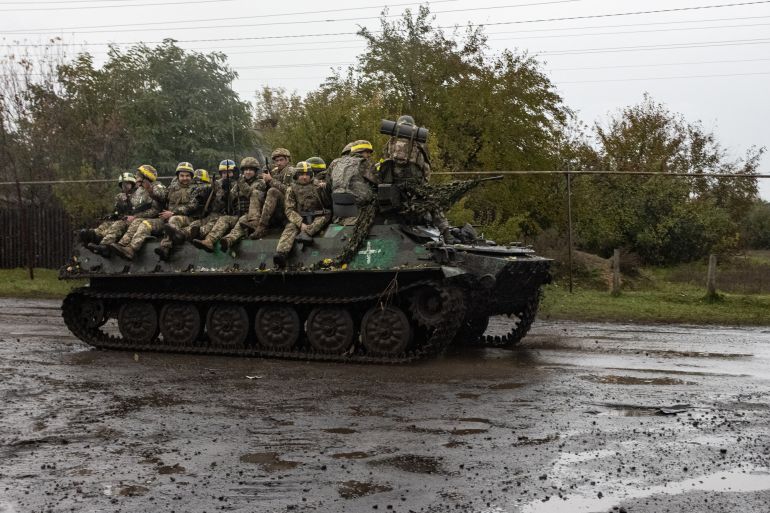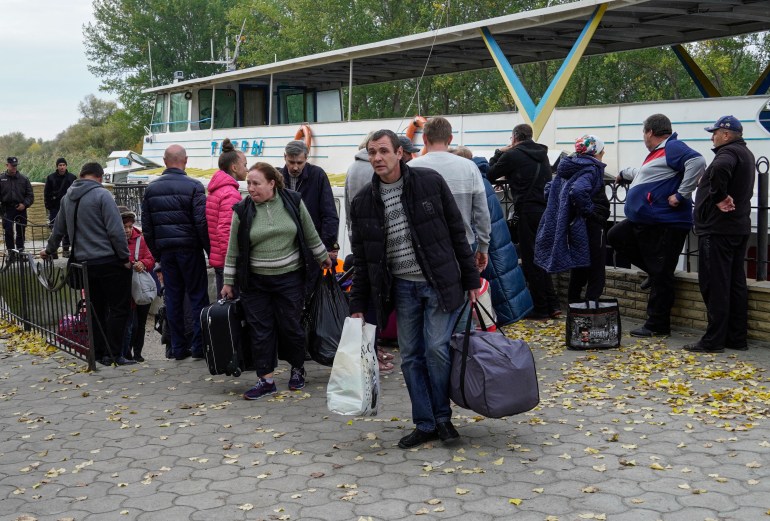Ukraine says southern offensive complicated by weather, terrain
Kyiv official says wet weather and the terrain in the Kherson region have made Ukrainian offensive there more difficult than a previous offensive in Kharkiv.

Ukraine’s counteroffensive against Russian forces in the southern Kherson region is proving more difficult than it was in the northeast because of wet weather and the terrain, Ukraine’s defence minister has said.
Kyiv’s forces are piling pressure on Russian troops in the strategically important Kherson region, which has been partially occupied by Moscow since the start of its invasion, threatening Russian President Vladimir Putin with another big battlefield setback.
Keep reading
list of 4 itemsWill Russia’s Vladimir Putin go nuclear?
Biden, Sunak agree to stand by Ukraine in first call
As Ukraine war drags into ninth month, Russia’s woes worsen
“First of all, the south of Ukraine is an agricultural region, and we have a lot of irrigation and water supply channels, and the Russians use them like trenches,” Ukraine’s Defence Minister Oleksii Reznikov told a news conference on Wednesday. “It’s more convenient for them.”
“The second reason is weather conditions. This is the rainy season, and it’s very difficult to use fighting carrier vehicles with wheels,” he said, adding that this reduced the options for Ukraine’s armed forces.
“The counteroffensive campaign in the Kherson direction is more difficult than in the Kharkiv direction,” he added.
Earlier, a Moscow-installed official in the region said at least 70,000 people have left their homes in the province in the space of a week, after residents were urged to leave by the pro-Russian authorities amid the Ukrainian offensive.
“I’m sure that more than 70,000 people left in a week since the crossings were organised,” Vladimir Saldo told a regional TV channel, referring to efforts to move residents to the Russian-controlled areas on the left bank of the Dniper River.
He added that this number may be larger as people could have used their own boats to cross the river instead of organised ferries.

Kyiv has compared this movement of people to “deportations”.
Saldo also said entry had been banned to the right bank area of the region for a period of seven days “due to the tense situation on the contact line”, according to a statement on his social media.
He also claimed there was an “immediate danger of flooding” and “mass destruction of civilian infrastructure”, saying Kyiv was preparing a strike on the Russian-controlled Kakhovka dam on the Dnieper River.
Ukrainian President Volodymyr Zelenskyy has accused Russia of planning to blow up the facility – crucial for the water supply of the Russia-annexed Crimean Peninsula – to trigger a devastating flood.
Nuclear concerns
The prospect of a new setback for Russia in southern Ukraine after its troops retreated from Kyiv and later in the northeast has fuelled fears that Moscow could use a nuclear weapon. Putin has warned repeatedly that Russia has the right to defend itself using all its arms.
However, Reznikov said: “My personal opinion is that Putin won’t use nukes.”
Moscow, which has the world’s largest nuclear stockpile, has launched waves of conventional missile and drone strikes targeting Ukraine’s energy infrastructure since October 10. The escalation followed a series of Russian battlefield defeats in September and an explosion on the Kerch bridge, which links occupied Crimea to Russia.
Kyiv says the Russian attacks damaged up to 40 percent of the country’s power system.
Temperatures can fall far below zero degrees Celsius in winter, now just weeks away, and Kyiv has urged foreign partners to step up their deliveries of air defences to help.
Reznikov said that in the next 10 days, he expected Ukraine to take delivery of sophisticated anti-aircraft National Advanced Surface-to-Air Missile Systems (NASAMS) provided by the United States.